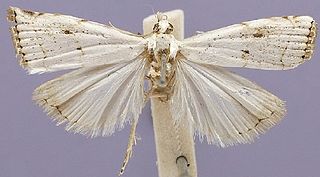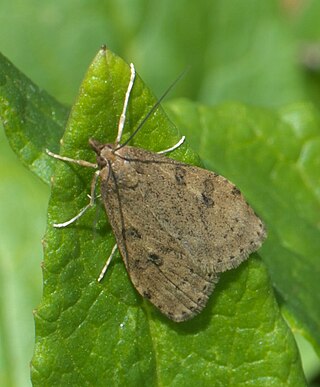
The small fan-footed wave is a moth of the family Geometridae. The species was first described by Johann Siegfried Hufnagel in 1767.

The sycamore is a moth of the family Noctuidae. The species was first described by Carl Linnaeus in his 1758 10th edition of Systema Naturae. It is distributed through most of Europe, from central England south to Morocco. To the east it is found from the Near East and Middle East to western Asia.

Phragmataecia castaneae, the reed leopard or giant borer, is a moth of the family Cossidae. It was described by Jacob Hübner in 1790. It is found in central and southern Europe, the Middle East, the Caucasus, Transcaucasia, Turkmenistan, Kazakhstan, north-western Iran, Iraq, Syria, Sri Lanka, Madagascar, India, Lebanon, Turkey, western China, south-western Siberia, Egypt, Tunisia and Morocco.

Catharylla is a genus of moths of the family Crambidae. It has Neotropical distribution from Costa Rica to southern Brazil.

Catharylla bijuga is a moth of the family Crambidae described by Théo Léger and Bernard Landry in 2014. It occurs in lowlands of the Guianas and Brazil.

Catharylla chelicerata is a moth of the family Crambidae described by Théo Léger and Bernard Landry in 2014. It is found in French Guiana and Amazonas, Brazil.

Catharylla coronata is a moth of the family Crambidae described by Théo Léger and Bernard Landry in 2014. It is found in Brazil.

Catharylla mayrabonillae is a moth of the family Crambidae described by Théo Léger and Bernard Landry in 2014. It is found in Costa Rica, Panama, Colombia, Venezuela, the Guianas, Ecuador, Peru, and Brazil.

Catharylla serrabonita is a moth of the family Crambidae described by Théo Léger and Bernard Landry in 2014. It is found in the Brazilian states of Bahia and Espírito Santo.

Catharylla tenellus is a moth of the family Crambidae. It is found in the Atlantic Forest of Brazil in the states of Bahia, Minas Gerais, Paraná, Rio de Janeiro, and São Paulo.

Catharylla paulella is a moth of the family Crambidae described by William Schaus in 1922. It is found in Brazil and Bolivia.
Nymphicula mesorphna is a moth in the family Crambidae. It was described by Edward Meyrick in 1894. It is found in Myanmar, Japan and Taiwan.
Musotima acrias is a moth in the family Crambidae. It was described by Edward Meyrick in 1884. It is found in Australia, where it has been recorded from New South Wales and Tasmania.
Eudonia singulannulata is a moth in the family Crambidae. It was described by Wei-Chun Li, Hou-Hun Li and Matthias Nuss in 2012. It is found in China.

Frechinia helianthiales is a moth in the family Crambidae. It was described by Mary Murtfeldt in 1897. It is found in North America, where it has been recorded from Arizona, Illinois, Manitoba, Missouri and Oklahoma, south to Mexico.

Metasia familiaris is a moth in the family Crambidae. It was described by Edward Meyrick in 1884. It is found in Australia, where it has been recorded from New South Wales and Tasmania.
Pycnarmon macrotis is a moth in the family Crambidae. It was described by Edward Meyrick in 1897. It is found in the Talaut Islands of Indonesia.
Samea antisema is a moth in the family Crambidae. It was described by Edward Meyrick in 1886. It is found on Vanuatu.

Udea turmalis is a moth in the family Crambidae. It was described by Augustus Radcliffe Grote in 1881. It is found in North America, where it has been recorded from Alberta, Arizona, British Columbia, California, Colorado, Idaho, Manitoba, Montana, Nevada, New Mexico, Utah and Washington.
Galagete consimilis is a moth in the family Autostichidae. It was described by Bernard Landry in 2002. It is found on the Galápagos Islands.













